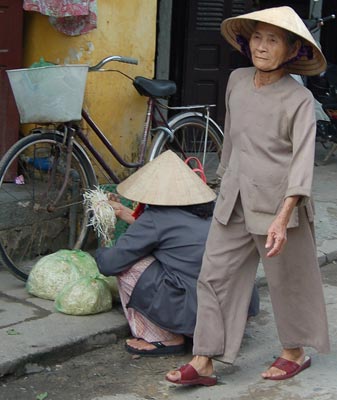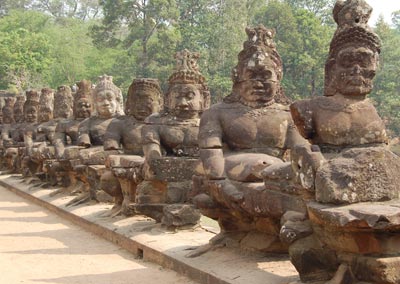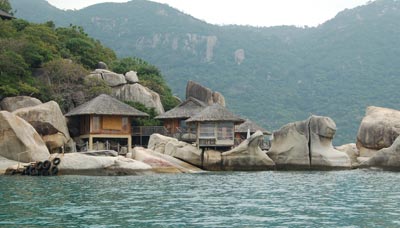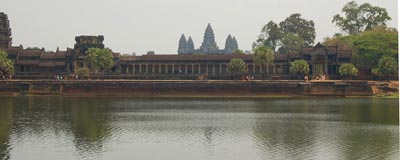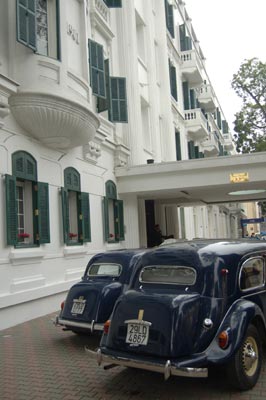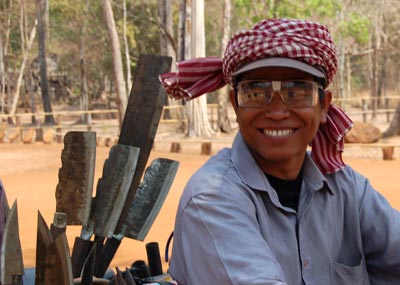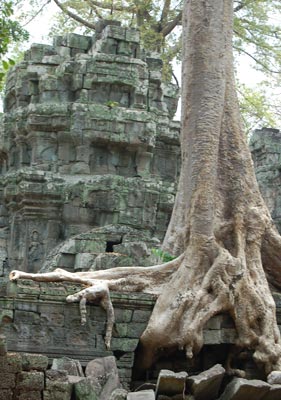Vietnam and Cambodia: Luxury travel with an eye on sustainable tourism
by Roger Canfield, Contributing Editor
Vietnam is a country of great natural beauty. I was particularly impressed by Ha Long Bay and the beaches at Hoi An and Nha Trang. All the people I met were patient, polite, gracious and gentle, and I found myself surrounded by a festival of colors and smells of often artistically arranged flowers, fruit, fish and vegetables.
Beyond visiting many attractions and learning about Vietnam and Cambodia, the focus of my March ’08 tour with Big Five Tours & Expeditions was on showing how tourism can support the local economy while helping to preserve the cultural and natural heritage of the people.
Throughout the tour, Costas Christ, our guide and a recognized expert on sustainable-tourism issues, also pointed out examples of how mass tourism is having a negative impact on local communities.
Settling in
I arrived in Hanoi at midnight after 30 hours of travel (including stopovers).
Eyes transfixed, I took a fascinating ride over long causeways across the floodplains of the Red River Delta into the energy-poor city. Hanoi’s dark streets were empty except for a few motorcycles laden with mountains of flowers.
Upon our arrival at the Sofitel Metropole Hanoi, a 5-star French colonial hotel built in 1901 (with modern additions made in 2008), we were fed fine French cuisine accompanied by live violin and piano music at the expensive but dark Le Beaulieu.
Up early the next morning, I walked through the Metropole’s courtyard, filled with green palms and mandarin orange trees, their colors highlighted by tall white walls.
Strolling the streets of Hanoi in daylight, I saw streams of motorbikes, many carrying great mounds of produce and other goods and, some, whole families. As if arranged by some hidden choreographer, all flowed calmly through interweaving traffic, often through 4-way intersections without traffic lights. Do nothing abruptly and you’ll find yourself cautiously at home in this orderly traffic flow.
I rejoined my group and we walked and rode cyclos (bicycle rickshaws) through the 2,000-year-old Old Quarter of Hanoi, finding streets named after the products sold on each. The Metropole has an excellent map listing types of goods and the multiple addresses at which they can be found.
We also visited Hanoi’s Museum of Ethnology (www.vme.org.vn; closed Mondays), containing indoor and outdoor exhibits on the 54 officially recognized ethnic groups of Vietnam.
Ha Long Bay
Perhaps one of the most enchantingly peaceful fantasylands on Earth is the natural wonder of spectacular Ha Long Bay, located east of Hanoi off Highway 5 in Quang Ninh Province.
Here, Big Five had scheduled an extraordinary 2-day luxury cruise-tour on the Jasmine Halong, a newly built replica of a traditional Asian junk. My cabin offered views of emerald water, white rocks, ancient boats and fishing villages.
Ha Long Bay has a magnificent seascape of nearly 2,000 closely packed lush islands — peaks and rocks jutting, high and low, out of emerald waters. These limestone “dragon’s teeth” are a photographer’s paradise.
Thousands of years of wear by water and wind have created sea caves and a labyrinth of lagoons. Over three days I climbed thousands of steps to see old temples and one massive cave of stalactites and stalagmites. Others enjoyed the beaches. I saw none of the advertised monkeys, sea eagles and other wildlife, however.
Here, natural beauty coexists starkly with great poverty. It was heart rending seeing mothers and their children selling broken seashells to tourists out of weathered, rough rowboats.
Resort stay
Next we flew to Da Nang, then drove 30 miles south past abandoned U.S. military facilities and Ngu Hanh Son (Marble Mountains), continuing along China Beach to the historic port and commercial center of Hoi An on the banks of the Thu Bon River.
Here, visitors can find architectural remnants of old cultures now largely gone from Vietnam. Hoi An’s Chinese ambience, reflected in its tile roofs, narrow streets, lacquered wood and carved stone, remains as it has for centuries.
This quaint port town has scores of world-class tailor shops that make custom clothing — fine dresses and business suits — in one day using quality fabrics. We all were happy with the service and the quality of our purchases ($115 for my suit) from the tailor shop Yaly (47 Tran Phu St.; www.yalycouture.com).
We stayed at the widely acclaimed Nam Hai luxury resort (www.ghmhotels.com) on Ha My beach, only 10 kilometers north of Hoi An. Large palms accented terraced shallow pools, a bar, a restaurant, a library and large private villas — all overlooking the soft white sands of China Beach and the Cham Islands.
My Nam Hai quarters were far, far beyond my needs — nearly 1,000 square feet housing fine furniture, three showers and a Bose sound system. Nearby, one-hour massages ($90), a basketball court, a library and Internet access were available. Meals, massages and laundry were expensive but relative, I suppose, to the upscale accommodations.
Going green
From Da Nang, we flew over meandering rivers, white beaches and fish houses dotting the water below to Cam Ranh Bay, developed as a major base by Americans in the ’60s and controlled by the Soviet Union from 1975 to 1990.
We passed through the modern, hotel-rich resort town of Nha Trang, situated between jungle-covered mountains and white beaches and facing a blue bay dotted with islands. Its having the lowest humidity in Vietnam, although still sweltering, makes Nha Trang the most popular beach town in the country.
We went by speedboat to luxury of a unique sort at the Six Senses Hideaway (www.sixsenses.com) on Ninh Van Bay. I had my own 2-story villa on the beach, with a loft, a pool, air-conditioning and an outdoor shower. I had a multilingual private butler named Tram, a university graduate. Tram helped me keep on schedule, got my air-conditioner going, etc.
Kayaking, water skiing, snorkeling, biking, hiking, yoga, massages and cruising were among the activities available here. I greatly enjoyed our Vietnamese cooking class, discovering that the secret ingredient of Vietnamese salads is not, as my taste buds told me, sweet vinegar but lemon juice and palm sugar molasses.
Six Senses Hideaway is a beautiful place with a magnificent staff. The resort is in some ways a showcase of the best practices in sustainable tourism. The villas are designed to reflect the thatched, wooden, open architecture of Vietnamese villages while fitting almost seamlessly into the natural landscape of rocks, trees and sand. The staff tend to organic gardens and recycle bottles and cans.
The resort’s “Little Green Book” covers many other plans, big and small, for further environmental improvements.
Saigon
We flew from Cam Rahn Bay down the coast to land at Tan Son Nhat International Airport. We saw a hustling, free-spirited city, which everyone still calls Saigon despite its being renamed Ho Chi Minh City.
Old and new cafés, markets and pubs bristled with life. Some ornate French colonial architecture remains, such as Nha tho Duc Ba, or Notre-Dame Cathedral (only open for Sunday Mass, 9:30-11 a.m.); the Central Post Office (Dong Khoi St., District 1, opposite the cathedral), and City Hall (at the end of Nguyen Hue Street).
The Opera House, officially the Ho Chi Minh Municipal Theatre (Le Loi and Dong Khoi streets, Lam Son Square, District 5), is located between the Caravelle Hotel and the Continental Hotel, watering holes of the press corps during the Vietnam War.
From the open terrace of the rooftop bar atop the Rex Hotel, located around the corner and down a block from the Opera House, I saw a Saigon lit and lively at night, with motorbikes and people crowding the streets and sidewalks.
We stayed at the Sheraton Saigon (www.sheraton.com), just around the corner from the Caravelle.
Boating on the Mekong River, we saw the busy Saigon waterfront, with shacks and tile-roofed condos plus lots of boats carrying tourists, bananas and river dredgings. Later we arrived north of Saigon at the Cu Chi Tunnels, a 124-mile underground network containing command posts, hospitals and weapon factories used by the North Vietnamese during the war.
On to Cambodia
From Saigon we flew to Siem Reap, Cambodia, where we stayed at Hôtel de la Paix (www.hoteldelapaixangkor.com), yet another luxurious treat decorated with local art for sale. Helping to both restore and sustain the historical Khmer culture and economy, the hotel participates in and supports many Khmer community projects.
It supports a monk-run school called Life and Hope, which teaches sewing, cooking and hotel occupations to the poorest young women (ages 14-35) and helps them establish sewing businesses in their home villages. It also provides rice allotments to their families. By putting its tour members in places like Hotel de la Paix, Big Five actively supports important sustainable tourism efforts like this.
The hotel’s projects appeared to be the real deal. We dropped by the workshops of Artisans d’Angkor, a company of 1,000 employees engaged in recreating artistic crafts destroyed during the reign of the Khmer Rouge. Here, young people learn wood and stone carving, silk painting and weaving, lacquer techniques and painting to become certified as craftsmen and return to village workshops. The products created are sold to provide income to their rural families.
Our next stop was Cambodia’s famed Angkor temples. Scattered over many miles, the temples are recognized as some of the world’s most important archaeological wonders.
Off the beaten track, among areas still heavily mined, lies the village of Koh Ker, whose 30 archaeological sites were visited by only a thousand tourists in 2007. We passed by a jumble of mortarless stone-block walls and through weed- and vine-entwined red-stone gates and doorways, finding, through a final tumbling gateway, piles of stone debris below a massive pyramid in the jungle with steep steps to the top.
At Koh Ker, an organization called Heritage Watch (one of the projects supported by the Spirit of Big Five Foundation, the nonprofit arm of Big Five) seeks to protect the architectural treasures here. Heritage Watch is training villagers in microenterprises, including sugar palm candy, handicrafts, tourism activities and some foreign language skills. In this way, they seek to displace destructive looting of ancient temples with community economic development activities.
Touring temples
Next began our 3-day temple tour. Extraordinary things sometimes require extraordinary exertions. Walking and climbing through rocks and stairways in hot, humid air along miles of sun-blasted ground made every day of this portion of our tour a day of many water bottles and showers.
The sweat expended taking photos of Angkor’s temples was well spent. However, the resulting images were best enjoyed later in air-conditioning sipping a cold Angkor beer.
The first temple we visited, Prah Kahn, has been left as it was found in a strangling jungle of fig and banyan roots.
The temple of Bayon, part of King Jayavarman VII’s fortified 5-square-mile Angkor Thom, was surrounded by a 100-meter moat and an 8-meter-high wall. Long bridges guarded by rows of smiling gods and stern demons provided access over the moat. Everywhere were bas reliefs of serenely happy faces looking down from great, dark towers.
I skipped an elephant ride to walk past carved elephants and lions and climb through doorway after doorway to discover new carvings of dancers, bejeweled women, elephants, soldiers and detailed geometric inscriptions.
Banteay Srei, a 10th-century temple dedicated to the many-armed Hindu god Shiva the Destroyer, is smaller in scale than other Angkor temples but grand in the intricacies of its carvings. I found the depictions of goddesses and battles particularly intricate and artistic.
The best-known temple, dedicated to Vishnu the Preserver, was saved for our last day. We approached Angkor Wat, dominated by five dark, pineapple-headed stone towers, by taking a long causeway over a moat guarded by stone cobras and a lion, continuing through a hardscrabble gate to an incense altar below a modern statue of the 8-armed Vishnu. Most intricate here were figures of winsome young maidens, reenactments of battle scenes and close-ups of chariot riders.
The details
Big Five Tours & Expeditions (Stuart, FL; 800/244-3483 or 772/287-7995, www.bigfive.com) offers custom tours in addition to their scheduled programs.
This particular tour was designed in conjunction with Costas Christ and the Spirit of Big Five Foundation. It was a customized version of their 15-day “Vietnam & Cambodia” tour, which starts at $3,090 per person, and it can be replicated (guided but without the services of Costas Christ) starting at $3,650 per person (single supplement starting at $1,950), including accommodations, most meals and all in-country flights.
Roger Canfield was a guest of Big Five Tours & Expeditions.


